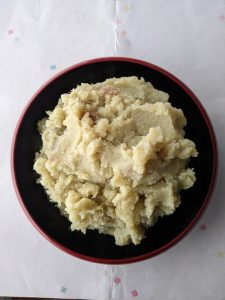Kuri Kinton: A Sweet Potato Delight for the New Year
The start of the new year in Japan, referred to as O-shogatsu, is a true culinary celebration. A hallmark of this festive period is the traditional New Year’s Day meal called Osechi, which features a delightful array of special dishes, making it my all-time favorite holiday. Of course, preparing and cooking together with my daughter makes it all the more enjoyable, but let’s be honest – it’s the yummy food that we look forward to most!
Among the many delicious dishes that grace the table during this time, one standout is Kuri Kinton, a sweet potato puree blended with sweetened chestnuts. Chestnuts hold special significance across various regions in Japan, with the Tamba area in Hyogo Prefecture producing some of the tastiest varieties. In Gifu Prefecture, you can also find a unique sweet made from slightly sweetened mashed chestnuts, formed into cute chestnut shapes, which is a beloved local specialty.

According to the historical cookbook Ryori monogatari or “The Story of Food,” the original version of kinton (meaning “golden cushion”) was a type of dumpling served in miso soup. A sweeter, dessert-inspired variant began to emerge near the end of the Meiji era (1868-1912) as an imitation of traditional Chinese sweets. Originally, sugar was used mostly as a preservative, which sometimes leads Kuri Kinton to being on the sweet side — feel free to adjust sugar levels to match your personal taste preferences. Personally, I love a less sweetened version.
Initially, this treat was made solely from candied chestnuts, but rising prices eventually led to the inclusion of sweet potatoes. Nowadays, while chestnuts aren’t mandatory, they provide wonderful flavor and a satisfying crunch amidst the creamy texture. You can find sweetened chestnuts at specialty stores or online, or you can take on the challenge of making them yourself (although it can be quite labor-intensive!). If you’ve never tried Japanese sweet potatoes, known as satsumaimo, they are somewhat akin to yams but feature a reddish skin and a bright yellow, sweeter interior when boiled, compared to their American counterparts.
Kuri Kinton is typically served as a side dish during the Osechi feast, but don’t let leftovers go to waste! It’s also delightful spread on toast as a jam or enjoyed alongside hot green tea or matcha, the special powdered green tea often used in traditional tea ceremonies.
Ingredients
- 2 lbs of Japanese sweet potatoes (satsumaimo), peeled and sliced into ½-inch rounds
- 3/4 cup white sugar (or adjust to taste)
- 1/3 tsp salt
- 1 tbsp mirin (sweet sake)
- 1 jar/can sweetened chestnuts in heavy syrup (use at least 6, cut in half or left whole if small)
- 2 tbsp heavy syrup from the chestnuts (or substitute with 1 tablespoon honey and 1 tablespoon water)
Optional Garnish:
- Whole sweetened chestnuts, drained of heavy syrup
Instructions
Prep the Sweet Potatoes: Start by soaking the sliced sweet potatoes in water for at least 30 minutes. This helps eliminate excess starch. Don’t forget to change the water a couple of times. After soaking, drain the potatoes.
Boil: Place the sweet potatoes in a medium-sized saucepan, cover them with water, and boil for about 15 minutes, or until they’re tender. You can check for doneness by inserting a bamboo skewer; it should pierce easily. Once they’re done, drain the potatoes and mash them! You can use a mortar and pestle, a potato masher, or even a food processor for a super smooth finish. A wooden spatula along with a fine-meshed strainer will also do the trick.
Combine Ingredients: Transfer the mashed sweet potato back to a clean saucepan. Stir in the sugar, salt, mirin, and syrup. Heat the mixture over medium heat, continuously stirring and mashing with a wide wooden spoon. The mixture will get very hot, so be cautious. Once it starts thickening, add the drained chestnuts. Continue to cook on medium-high heat for around 5 minutes, stirring to ensure everything is well combined. The mixture should be thick enough that it clings to the spoon without falling off; so cook longer if needed.
Serve: Let the Kuri Kinton cool to room temperature, then serve it in a large bowl or in individual portions for your Osechi feast. If you have any leftover chestnuts, feel free to place some whole ones on top as a lovely garnish!
Notes
This recipe makes a generous amount of Kuri Kinton, so if you’re preparing for a smaller gathering, consider halving the ingredients!
Frequently Asked Questions
- 1. Can I use regular potatoes instead of sweet potatoes?
- While you technically can, the unique flavor and sweetness of Japanese sweet potatoes contribute significantly to the dish’s overall taste, so it’s best to stick with them for authenticity.
- 2. How can I store Kuri Kinton leftovers?
- Store any leftover Kuri Kinton in an airtight container in the refrigerator for up to 3 days. You can enjoy it cold or gently reheated.
- 3. Is it necessary to use chestnuts?
- Chestnuts are not mandatory for this dish; however, they provide a delicious texture and flavor that enhances the overall experience of Kuri Kinton. You could make a chestnut-less version if preferred.
- 4. Can I adjust the sweetness of Kuri Kinton?
- Absolutely! Feel free to adjust the sugar according to your taste. Start with the recommended amount and add more if you like it sweeter.
- 5. Can Kuri Kinton be served warm?
- While Kuri Kinton is traditionally served at room temperature, it can also be enjoyed warm if that’s your preference!











